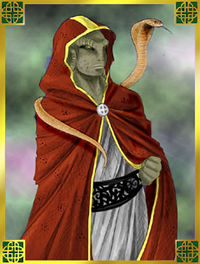Hav'roth: Difference between revisions
Jump to navigation
Jump to search
mNo edit summary |
No edit summary |
||
| Line 28: | Line 28: | ||
*Hav'roth gave [[S'Kra Mur ]]the Gifts of Mind: Language, Creativity, & Magical Talent |
*Hav'roth gave [[S'Kra Mur ]]the Gifts of Mind: Language, Creativity, & Magical Talent |
||
==Kaldaran Version== |
|||
| ⚫ | |||
The god of earth, flame and smiths. He is the guardian of the [[Kaldar]]; he who warms them through the winter, he who defends against the [[Ocular]], and he who guides the hammer of the smith. Weapons and armor that do not bear his blessing are not to be trusted, and even common tools are traditionally forged in his name. His symbol is a hammer wreathed in flames. (Like all the Gods, he is traditionally depicted as a Kaldar.) |
|||
{{RefAl|a=-}} |
|||
| ⚫ | |||
Revision as of 18:22, 23 December 2011
God of the spirits of rock and stone, and of the earth -- deserts are his domain. Hav'roth is the creator of precious metals and gems. Chief deity of the S'Kra Mur.
Symbol
Cobra
Other Aspects
Light - Peri'el
Dark - Ushnish
Altar Locations
- Crossing Temple, Eyes of the 13
- Northern Central portion of Ratha Tier One.
- In the Forest of Night - No Favor Orbs
- In his temple in Muspar'i
- Fornsted Chapel No favor orbs
Proper Offerings
- gems (300+ value)
- cobra beads
- parchment cobra primers
- Immortal Hav'roth cards
Fun Tidbits
- Both Hav'roth and Peri'el are noted to have given the gift of shorter snouts to S'Kra Murs
Those who were not gifted refer to themselves as the S'Kra'Ur(The True People).
- Hav'roth gave S'Kra Mur the Gifts of Mind: Language, Creativity, & Magical Talent
Kaldaran Version
The god of earth, flame and smiths. He is the guardian of the Kaldar; he who warms them through the winter, he who defends against the Ocular, and he who guides the hammer of the smith. Weapons and armor that do not bear his blessing are not to be trusted, and even common tools are traditionally forged in his name. His symbol is a hammer wreathed in flames. (Like all the Gods, he is traditionally depicted as a Kaldar.)
